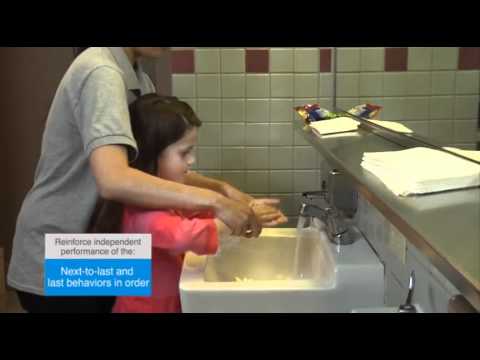What if I could tell you about an ABA teaching strategy that will actually save you time, help your students learn faster, address prompt dependence, and help them master skills more efficiently? Would you want to use that strategy? Read on to learn more about forward and backward chaining.
In my last post of the Effective Interventions in ABA series, I talked about task analysis and how important it was that the tasks be broken down into smaller components and taught sequentially. I also talked about the need to make sure everyone is using the same task analysis steps. That’s going to become even more important if you use chaining.
I talked in this post about using shaping as a way to reinforce successive approximations to the skill you are trying to teach.
So What Is a Chain?
Some task analyses are set up as chains of activities that lead to completion of a task or skill. Washing hands is probably the most classic example, but it can be any type of task that requires you to do steps in a sequential order to get to the end product. You could teach using a calculator as a chaining task (e.g., turn on, type in the first digit of the price, the decimal, the second digit of the price and the third, press plus, press in the price of the next item (first, second third), press equal, write down the sum of the prices). The steps make up a chain.
How Do We Usually Teach?
So, if you have a chain of steps as your task analysis, most of us tend to teach each individual step. When I say teach, I mean going through that prompting hierarchy and waiting for independence between each step. In other words, we walk to the sink and wait. Then if the student doesn’t turn on the water, we point to the faucet. If that doesn’t work after a few moments, we put the student’s hand on the faucet and wait and if that doesn’t work we do hand over hand or full physical prompting. And then we do the same procedure for the next step, and the next step, and the next step. This procedure is called total task teaching. Essentially we are introducing each step and working toward independence on each step all at the same time.
So, let’s imagine you have 5 students in your classroom (because it makes my math easier, not because I actually think you only have 5 students). Let’s say they all go to the bathroom around the same time during the day and all 5 of them are working on learning to wash their hands independently using a task analysis. If you are using total task teaching, how long is it going to take you to get through just the hand washing part of the bathroom? Let’s say you wait 5 seconds between each prompt you give (probably not long enough, but let’s keep it simple). Let’s say your hand washing task analysis has 8 steps like the one below. And let’s say you are using a 3-step prompting strategy like I described above (read more about that here). So, just for the sake of math, let’s say this student is not independent at any of the steps in the task.
So, we have 8 steps times 3 prompts per step (24) times 5 seconds waiting between prompts (24×15=360 seconds or 6 minutes). So, for each student washing his or her hands, just the prompting (forget the playing in the water, the getting the soap and the other parts of actually washing hands), will take 6 minutes times 5 students (if only one person is staffing the bathroom). That’s 30 minutes just to get all the students’ hands washed, teaching them how to do the task. Hmmm, I’m guessing that at some point people start jumping in and helping the kids more in order to move things along.
Just prompting a group of 5 students through hand washing with total task teaching could take 30 minutes. Chaining might be a better way.
What is Chaining?
So, total task, probably not the most efficient methods for instruction. Chaining is teaching the task by only teaching to independence on one of the steps of the task analysis. So, instead of going through that prompt fading routine described above for each of the steps of the task, you only do that for the first step (forward chaining) or the last step (backward chaining). Then you do the rest of the task either with or for the student. So, if we think about our math problem above, that would be 1 step @ 15 seconds times 5 students = 1 minute and 15 seconds devoted to prompting and fading prompts.
Forward Chaining
Forward chaining the most intuitive of the chaining procedures. In forward chaining, taking our hand washing task analysis, you would tell Max to go wash his hands and wait to see if he walks to the sink. If he doesn’t in 5 seconds, you would point to the sink. If he doesn’t go to the sink after 5 seconds, you would maybe physically guide him toward it. If that wasn’t effective after 5 seconds you would take him to the sink. Then you would do the rest of the task with him hand-over-hand. When he began to go to the sink independently, then you would tell him to wash his hands, he would go to the sink on his own and you would go through the same prompting strategy with turning on the water and then physically prompt him through the rest of the steps. And you keep doing this as he masters each step in order until he can complete the whole task independently. At the end of the series, if his step was more independent than the last time or met criteria you had set (e.g., independence, less intrusive prompting), he would get a reinforcer.
Backward Chaining
Backward chaining is the same principle, but instead of teaching the first step first, you would physically prompt Max all the way through the first 7 steps, and then wait for him to throw away his towel. If he didn’t you would gesture, then give a partial physical prompt and then do a full physical prompt. Once he was independently throwing away the towel, you would physically prompt him through all the steps up to getting a towel and drying his hands. You would then prompt him to do that using the same procedure. and then he would throw away the towel independently and get a reinforcer if his performance of getting the towel met the criteria of more independence. And then you would just keep moving backward up the chain until he was independent at the whole skill.
Here is a video that demonstrates it because I know that backward chaining is hard to get your head around sometimes.

Tips for Chaining Procedures
We don’t have any research indicating whether forward or backward chaining is better. In fact most of the research seems to indicate that there are probably individual differences among learners with some benefitting more from forward chaining and some benefitting more from backward chaining. It’s possible that it also is related to the task being taught and that one or the other is more effective for specific tasks (Slocum & Tiger, 2011). The following are some thoughts based on my experience of how to decide and how to best implement both.
- Chaining strategies work well for tasks like daily living skills and skills that have a motor component so that you can provide physical prompting.
- Forward chaining is more intuitive and easier to explain to people. It makes more sense to go forward so people understand it better.
- Forward chaining is good if you have a student with difficulty initiating an action. He will practice the first steps more times independently so he is more likely to initiate the action on his own out of habit when the instruction is finished.
- Backward chaining is more connected to the reinforcement because the student finishes the independent steps and gets the reinforcer right afterward. So the time between the independent step and the reinforcer is shorter.
- Backward chaining is probably good for students who sometimes stall out mid-task and need a prompt to get moving again. For these students, they will have practiced the final steps more frequently independently than the early steps so the task will get easier and more habitual as they go through it.
- For both types of chaining, I highly recommend teaching the skill by giving the verbal instruction one time and then not using verbal prompts for any of the other steps or prompts. So, you would say “Wash your hands” not “go to the sink.” It’s hard to remember to do this, but the verbal prompts for many of our students become a cue for them and they will wait for it often. This is how our students often become prompt dependent. Giving the direction of what you want them to do (the whole task), and then silently giving prompts makes it more likely that students will use the cue before it to give them information about the next step (e.g., my hands are wet, I must need to dry them) instead of the adult telling them what to do.
Giving the student the direction of what you want him to do (the whole task), and then silently giving prompts requires the student to rely on the steps of the task instead of the adult and builds independence.
So, how efficient your teaching is depends in part on the size of the steps in the task analysis, but also on what strategy you use to teach it. Have you tried chaining strategies in your classroom? Share your experience with us. Have more questions about it, share them in the comments and I’ll try to answer as best I can.
For the continuation of the Effective Interventions in ABA series, check out this post about shaping, another way to use task analysis.






![Summer resources to help survive the end of the year in special education [picture-interactive books with summer themes]](https://autismclassroomresources.com/wp-content/uploads/2018/05/SUMMER-RESOURCES-ROUNDUP-FEATURE-8528-768x768.jpg)

